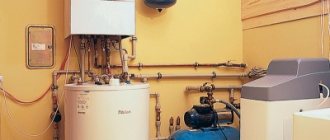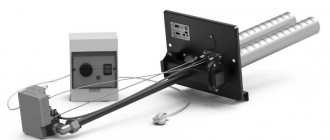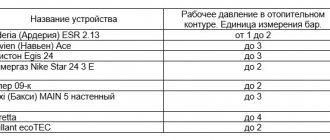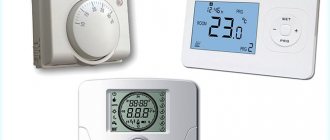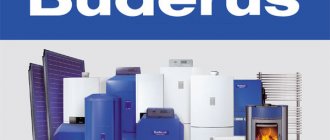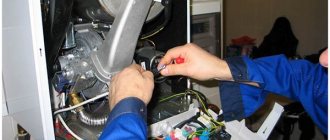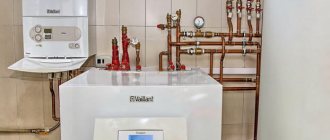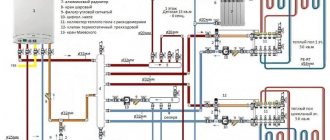Here you will learn:
- Scope of application of heating elements for heating
- Pros and cons of radiator heating elements
- How are they used for heating radiators?
- Types and methods of manufacturing heating elements
- Criterias of choice
- How to install and use heating element correctly
- Radiator electric heating at home
- Rules of operation and maintenance
Heating elements for heating are used in various devices, ranging from electric fireplaces to cast iron radiators. Installing a heating element is a simple and quick procedure; it is connected directly to the electrical network and has high efficiency. The downside is energy costs.
Scope of application of heating elements for heating
Electric heating elements have gained popularity due to their versatility and high efficiency. All the electricity they consume is used for its intended purpose - heating the surrounding space.
The main heating devices where heating elements are used are:
- Portable and stationary oil electric heaters.
- Water heating radiators.
- Bathroom heated towel rails.
- Electric fireplaces.
- Electric convectors.
- Electric boilers.
The specified equipment can be used as a main or additional heating source. It is inexpensive, easy to install and does not require special skills to operate.
You can connect the heating element to a cast iron central heating radiator after disconnecting the common riser. This device can be used for main and additional heating
How big is the benefit from heating elements?
If you have an old battery, then why not use a heating element to turn it into a heating system for a small utility room - a chicken coop, a workshop, a garage.
There are even myths that heating with heaters is beneficial. But “dreams are shattered by harsh reality” - heating with electricity is the most expensive. Since the most expensive energy carrier is used.
It doesn’t matter whether there is a proprietary programmable electric boiler, or a barrel with a heating element lowered into it on a wire, the efficiency of such electric heaters is about 97%. And then we pay according to the meter...
Heating elements for heating with a thermostat, features of choice
Every homeowner wants to have an economical and trouble-free heating system in their home.
The variety of existing types of heating allows you to choose an individual and optimal solution for the needs of each home.
The main thing in the heating system is the coolant heater. Various boilers heat the coolant and it, entering the radiators, releases the accumulated heat to the room. If the boiler breaks down, all radiators are excluded from the heating system of the house, and in cases of severe frosts, the water in the system can turn into ice and simply rupture the radiators.
Electric heating elements for heating with a thermostat allow you to avoid these problems, as well as increase stability and increase the power of the entire heating system. In many cases, they can be used to create an autonomous local heater.
Pros and cons of radiator heating elements
Tubular-type electric heaters make it possible to assemble a practical and fairly efficient heating system for main or additional heating.
The advantages of the devices include:
- Extreme ease of installation. Every novice master can handle this job.
- The low cost of the device, however, refers to the price of one heating element, without additional equipment.
- Greater reliability compared to oil radiators. In addition, batteries with heating elements are repairable. If the equipment fails, it will be enough to replace the heater.
- Availability of additional options and functionality.
- Possibility of automatic control of the heating system, but this will require additional equipment.
We have listed the main advantages of radiator heating elements; we will consider their significant disadvantages. There are quite a lot of them. First of all, these are impressive operating costs, which is explained by the high cost of electricity. They can be reduced if the heating system control is fully automated.
In this case, the heating elements will be switched on only after the room temperature drops to a certain minimum value. And turn off when the temperature defined as comfortable is reached. Working in this mode is as economical as possible.
The simplest radiator heating elements in design are not equipped with automatic control. To automate such a system, you will need to purchase additional equipment
However, automation equipment will require financial investment. If we consider purchasing a heating element complete with a radiator and automation, the cost of such a kit will be much higher than the price of an electric convector or an oil radiator.
But at the same time, in terms of the level of comfort provided, the latter are in no way inferior, and in some ways even superior to radiators with heating elements. For example, the latter require permanent installation, while electric convectors and oil radiators are more mobile and compact.
In addition, like any other electrical device, heating elements generate a magnetic field during operation. Its danger to the body has not been proven, nor has its safety. Therefore, it is worth attributing the presence of such a field to the negative qualities of devices, because they are mounted in radiators, that is, they are in close proximity to people.
In other heating systems powered by electricity, this disadvantage is to some extent leveled out. For example, electric boilers are located in non-residential premises where human presence is short-term.
One of the most significant disadvantages of radiator heating elements is their relatively low efficiency. If we compare it with the efficiency of traditional systems operating with liquid coolant, it will be significantly lower.
This is due to the fact that in the first case the coolant moves at a fairly high speed. Thanks to this, the radiator warms up quickly and completely.
To increase the heat transfer of radiators equipped with heating elements, you can cover the wall on which the device is mounted with a reflective screen made of foil. Thermal radiation will only move into the room
The functioning of the heating element is not able to provide such a high speed. As a result, the heating of the battery case will be uneven. The temperature at the bottom will be much higher than at the top.
Considering that, for safety reasons, the battery should not be allowed to heat up above +70ºС, such a temperature will only be present in the lower part of the radiator, where the heating element is located. Consequently, in order to prevent overheating of the equipment, it will be necessary to reduce its power by about a third.
How are they used for heating radiators?
The main function of tubular-type electric heaters for radiators is to heat liquid in an autonomous or centralized heating system. The device is used as a secondary or main heat source.
As an autonomous system and the only coolant heater, heating elements are used in the following cases:
- The need to heat rooms where there is no other type of heating. This could be a workshop, garage or agricultural building. The main condition for installing a radiator electric heater is the small size of the building. It is more effective to fill batteries with oil of low viscosity, since it has a fairly low freezing point.
- Subject to periodic heating of the room. Most often, such structures are dachas with no main heating system. At the same time, the number of installed heating elements, their power must correspond to the volume of the room.
As an additional device to the main heating, a tubular electric heater can be installed:
- In multi-storey buildings. Heating elements are installed in radiators in apartments if the main heating is not particularly efficient. The device helps create and maintain the necessary indoor microclimate. But its installation requires limiting the access of water that circulates through the heating system of the entire house. In this case, the use of a heating element is completely impractical, since you end up paying twice for heating - for the operation of the electric heater and to the housing office for the use of the coolant.
- In private homes. A heating element is installed if it is not possible to regularly add firewood to a solid fuel boiler. In such a situation, the tubular heater does not allow the coolant to cool completely and the required temperature is constantly maintained in the room.
The heating element for the radiator is installed in both private and apartment buildings
Using heating elements for gas boilers does not make sense, since such units cope well with heating due to an automated system.
Types of electric boilers and their fundamental differences
Electric boilers differ in the type of working heating elements and are:
• Electrode type.
• Heating element type.
Electrode-type boilers for heating water use the property of water to conduct electric current, releasing heat. It is very simple to describe their basic structure: two electrodes are immersed in water and alternating current is passed through them.
Heating element boilers use a completely different principle. These electric boilers use special tubular electric heating elements (TEH) as a heating device.
Since these boilers have fundamental differences in the types of heating elements, the repair of electric boilers has significant differences.
Types and methods of manufacturing heating elements
Modern electric heating elements have high strength and the ability to change shape and size under the influence of high temperatures without compromising their technical characteristics. They are used not only in household heating appliances, but also in industrial ones. True, in the latter they install more powerful analogues with larger sizes. All modern heating elements have a high rate of long-term operation.
Manufacturers produce two types of heating elements, which differ in the manufacturing method. There are products that are mass produced, and there are also those that are produced in small batches. They usually meet specific customer requests. They are used in special heating installations with specific requirements. By the way, the price of the latter is much higher than the former.
Tubular electric heaters
This is the most common type of heating element, which is used in almost all electrically powered heating devices. With the help of tubular analogues, heating of the coolant occurs according to the principles of convection, radiation and thermal conductivity as a result of the conversion of electrical energy into thermal energy.
This heating element has the following characteristics:
- Tube diameter 6.0-18.5 millimeters.
- The length of the heating element is 20-600 centimeters.
- The tube can be made of steel, stainless steel or titanium (a very expensive device).
- Device configuration - no restrictions.
- Parameters (power, performance, etc.) - as agreed with the customer.
Finned tubular electric heaters
Used to heat air or gas that heats the room
TEHPs are the same tubular electric heater only with ribs that are located in planes perpendicular to the axis of the heating tube. Typically, the fins are made of metal strip and secured to the tube with special clamping nuts and washers. The heating element itself is made of either stainless steel or structural steel.
This type of electric heating devices is used to heat air or gas that heats a room. They are often used in heating devices such as air curtains and convectors - where heating with heated air is required.
Electric heater block
TENB are used only if it is necessary to increase the power of the electric heater. They are usually installed in devices in which the coolant is liquid or any bulk material.
A distinctive design feature of the heating element is its fastening to the heating device. It can be threaded or flanged. Particularly popular today is a block-type heating element with collapsible flanges. Such a heating element can be used repeatedly for different devices. The burnt heating element can be removed and a new one put in its place.
Cartridge-type electric heaters
This type is not used for heating systems.
This type is not used for heating systems. It is used as a mold part to create any products, since it is a part of industrial equipment. They are not found in everyday life, but it is necessary to mention them, because this type of heating element is included in the category “tubular electric heaters”.
A distinctive feature of this analogue is the shell, made of stainless steel, which is polished to the maximum. This is necessary so that the heating element can enter the mold with a minimum gap between the tube and the walls of the mold. The standard gap should not exceed 0.02 millimeters. This is how tightly it should fit.
Ring electric heaters
This type of heating elements is also used only in industrial installations. Their purpose is to heat injectors, nozzles of injection units and injection molding equipment.
The minimum twisting diameter is 8 millimeters, the maximum is not limited. The tube can be wound with the same or variable pitch. Typically this type is made only from stainless steel.
Electric heaters with thermostat
Heating element with thermostat TECHNO 2 kW
This is the most common heating element today, which is used to heat liquids. It is installed in all household electrical appliances that are associated with heating water. The maximum temperature of the released heat is +80C.
It is made from nickel-chromium wire, which is filled inside the tube with a special compressed powder. The powder is magnesium oxide, which is a good insulator of electric current, but at the same time has a high thermal conductivity.
TEN and its varieties
Structurally, a tubular electric heater (TEH) is a tube made of carbon or stainless steel with a heat-conducting spiral made of nichrome, a material with high resistance, placed inside. The tube is filled with a special coolant, periclase, which is a good insulator and, moreover, has a high thermal conductivity, and is hermetically sealed. Periclase, being under high pressure, fixes the spiral centered along the axis, so it does not move when the heating element is bent and, depending on the model, given the required shape. The ends of the spiral protrude from the outside, which serve to connect to the electrical network.
Heating heaters can be divided into groups according to several parameters:
- According to the type of heating surface, they are tubular, finned, rod, flat and strip:
- Tubular electric heaters are used in all electric heating devices in which heating of the coolant occurs as a result of the conversion of electrical energy and thermal energy. They are made of carbon and stainless steel, copper, titanium, usually from 20 to 600 mm in length from a tube with a diameter of 6 to 18.5 mm of any configuration and power;
- tape heaters made of sheet aluminum or stainless steel are used to heat a flat surface, for example, a heated floor, but most often in industrial production;
- flat heaters are produced with a spiral in a ceramic heater for heating flat surfaces, also in industry;
- Rod heaters are designed to work in holes in metal parts.
finned tubular electric heaters are used in thermal curtains and convectors to heat gas or air that heats the room. The fins, made of metal tape, are attached to the steel heating tube with special fasteners perpendicular to its axis. The branched outer surface makes it possible to increase its heat transfer at a lower temperature, weight and overall dimensions of the heating element;
In addition, heating elements, varying in power from 15 to 15,000 W per unit surface, may have additional options: thermostats and automatic shutdown sensors in case of overheating.
Criterias of choice
When selecting a heating element for a radiator, you should take into account its technical characteristics, as well as the parameters of the battery. The main factors influencing the choice of device are:
- Power. In rooms with good thermal insulation properties, heaters from 2 to 3 kilowatts can be installed. In older buildings, it is best to use heating elements with higher power.
- Length of the electric heating tube. It is recommended to purchase heating elements ten centimeters shorter than the battery. Correct selection of the length of the heating device allows you to evenly heat all sections of the radiator.
- Battery Type. In order for the heating element to optimally fit the radiator, you should carefully study its technical data sheet. It specifies which types of batteries the product should be used with.
- Automatic control. Not all models have this option. For ease of use, it is best to purchase heating elements with automation, which are equipped with a thermostat.
The heating element should be ten centimeters shorter than the radiator
The diameter of the electric heater is also taken into account in accordance with the cross-section of the plug on the radiator. It is important to correctly determine the placement of the thread.
It is necessary to purchase only high-quality heating elements from trusted manufacturers. Before purchasing an electrical appliance, you should check its integrity and serviceability.
How to install and use heating element correctly
The key parameter for any electrical appliance is its rated power. Therefore, in order to correctly install such a device in the heating system, this value must be calculated. After this, you need to study the rules for installing electric heating elements and only then get to work.
The outer shell of the structure must be located in water so that the heat from the coil is compensated by the low temperature of the water, and the heating element does not overheat. For this purpose, it must be installed at the lowest point of the radiators so that it does not enter the area of air pockets.
Water should be distilled because it contains a minimum of impurities. Such additives can form a layer of scale on the protective shell, which, in turn, can cause corrosion.
When installing a heating element in a heating system, check the instructions for how to seal the end joints in this case. If we are talking about additional sealing, this must be done, otherwise if water gets on the heating coil, there may be a danger for the occupants of the room.
Sealing joints
When installing the heater into the heating system, you must first read the instructions from the manufacturer. If it states that the end joints of the electrodes must be additionally sealed, this must be done. Otherwise, if water gets on the surface of the heating coil, the danger for those living in the house increases. After familiarizing yourself with these rules, you can begin installing a heating element.
Not every heating element is suitable for a heating radiator. Only special models with the appropriate mounting diameter should be selected.
Popular models of solid fuel boilers with heating elements
offers universal and budget models of solid fuel combination boilers: “Kupper PRO”, “Kupper OK”, “Kupper OVK” with heating elements with a power of 9 kW, as well as “Kupper Praktik”, the heating elements in which have a power of 6 kW (can be replaced with more powerful ones ).
Advantages of Teplodar combined heating boilers:
- High efficiency. The improved design of the heat exchanger makes it possible to increase the heat removal area by 60% without changing the overall dimensions of the boiler.
- Insulation of the housing with mineral cardboard minimizes heat loss.
- Solid fuel boilers "Kupper-OVK10" and "Kupper-OVK18" are equipped with a cast iron stove, which allows them to be used for heating or cooking.
- The design of the Kupper series boilers allows the use of all types of solid fuel. It is possible to switch to gas or pellets; in these cases, the boilers must be equipped with a gas or pellet burner, also produced at our factory.
- The basic package includes a block for installing heating elements designed to maintain the temperature after the end of the solid fuel combustion process. Boilers with a power of 15 kW can be equipped with an automatic draft regulator.
Boilers of the “Kupper” series are universal: they can be the basis for any heating system - open, closed, with forced or natural circulation of coolant. Design features allow you to connect the water circuit from any side, which greatly simplifies the installation of the heating system.
A solid fuel boiler with an electric heating element minimizes the risk of defrosting a system with a water circuit when regular lighting is not possible. Installing a hybrid “solid fuel/electricity” boiler will allow you to leave the system unattended for a short period of time, and also avoid replacing the water in the heating system with antifreeze. Reliable equipment guarantees safe operation of the heating system even in extremely low temperatures.
Radiator electric heating at home
Installation diagram of the heating element in the radiator
Before installing a heating element into the heating system, you need radiator parameters. The main one is the diameter of the connecting pipe. Currently, manufacturers produce products in two sizes - 1/2 and 3/4 inches. Then a comparative analysis of the heating parameters is carried out before and after installing the heating element.
Connecting the heating element to the existing heating
If it will be used as an additional method of heating water, you need to take into account the change in hydraulic pressure when passing through the radiator. Since the flow diameter of the system this month will be smaller, it is recommended to install a pump of higher power.
When connecting a radiator to the system, installing a heating element for heating the house will not be possible. To do this, you must either change the connection diagram to the top, or install a heating element on the top of the battery, which is not recommended by experts.
They are often installed in old cast iron batteries. Before performing work, you must first check the direction of the thread of the pipe (right or left) and also measure its diameter. Then you should follow this scheme:
- Coolant drain. It is prohibited to install a heating element into a heating radiator if there is water in it;
- Checking the battery level. Even at a slight angle of inclination, the likelihood of air pockets significantly increases;
- Installing the heating element into the pipe. To seal the holes, you must use the gaskets supplied with the heating element or make them yourself;
- Installation of a unit with a thermostat, if included.
An example of installing a heating element in a cast iron radiator
After this, you need to fill the system with water. Using the installed Mayevsky crane, possible air pockets are removed. Before switching on, to ensure safety, a tester is used to check any possible heating coil-battery circuit. If there is one, you need to dismantle the heating element and install it again, improving the sealing.
Radiator electric heating
When organizing heating using heating elements made by yourself, installation of a pipeline is not necessary. A heating element must be installed on each radiator. At the same time, it is possible to install models of different power depending on the thermal conditions in a specific room of the house. The advantages of such a system are as follows:
- Saving on the purchase of materials and reducing the labor intensity of installation work;
- If you use a heating element with a thermostat for heating and a temperature sensor connected to it, the degree of heating of the room will be adjusted automatically;
- Minimum system heating inertia.
But all these positive qualities can be offset by the total cost of service. Therefore, before heating with electric heaters, you need to calculate not only the cost of purchasing materials and components, but also the subsequent costs of electricity. Only after this should a heating system of this type be introduced.
It is recommended to purchase factory radiators with installed heating elements. Their operating efficiency is higher than that of homemade ones, since special oil is used as a coolant. Even when the heating element is turned off, it will give off heat to the room for some time.
How to choose heating elements
Heating element for heating with plates
How to choose the right heating element for a heating system? Currently, there are many manufacturers who offer similar products. However, both the quality and technical parameters do not always correspond to the required ones. Therefore, before purchasing, you need to pay attention to the following operational characteristics of the heater:
- Rated and maximum power. If a heating element is needed for a heating boiler, its power should be sufficient for the system to operate. The simplest method of calculation is per 10 square meters. at home you need 1 kW of thermal energy;
- Electrical network type. For models with power up to 3 kW, you can use a 220 V home network. If you plan to install a heater for a heating system of higher power, you should install a three-phase 380 V network. This may be due to difficulties in completing the documentation;
- The presence of a thermostat. For a radiator electric heating system, this is the main selection factor. If you purchase a heater without the ability to adjust the power, it will constantly work at maximum mode. This will dramatically increase electricity costs;
- Price. The average price of a 2 kW model starts from 900 rubles. The cost of more powerful ones can be up to 6,000 rubles. They are often made to order.
The appearance of the heating element can also affect its performance and efficiency. The best option would be to purchase a finned heating element for a heating boiler. It differs from conventional ones in that additional heat exchange plates are located on the protective shell.
Thanks to them, the heating area increases. This design is typical for heating elements in heating radiators of larger diameter. Reviews about them indicate increased heat transfer even at minimum operating mode. But their overall dimensions do not always make it possible to install them in a battery. Therefore, simple tubular type heaters are most often purchased. To increase efficiency, you can buy a block of heating elements with a thermostat. It differs from traditional ones by the presence of several heating elements on one base.
Rules of operation and maintenance
In order for the heating element installed in the heating battery to serve as long as possible, the following rules are observed:
- The heater turns on only if there is water in the battery. If liquid gets on the already heated tube of the device, a small thermal explosion may occur. As a result, not only the heating element will fail: the heating battery may be damaged.
- During operation of the device, scale will form on its surface, which must be cleaned off periodically. The recommended maintenance schedule is once every three months. If the thickness of scale on the heating tube exceeds 2 millimeters, heat transfer will decrease and the device may fail.
- To eliminate possible voltage surges, it is recommended to connect the heating element through an uninterruptible power supply or stabilizer. When installed, the heater is grounded.
- Manufacturers recommend using only distilled water as a coolant. In apartment buildings with a common riser, it is unrealistic to comply with this requirement, so it is necessary to clean the heating elements from scale more often.
How to use it correctly
In addition to the banal failure to follow the operating instructions and safety regulations, heating elements can break due to:
- shell corrosion;
- its rupture as a result of overheating;
- constant changes in mains voltage;
- and just a general depressurization of the tube.
In order for the device to heat your home for as long as possible, you need to follow simple rules:
- When connecting the wires, you should not be too zealous and over-tighten the contact nuts of the output ends of the heating element - they may burst.
- The device must be connected to the network only when it is in water. Otherwise, lowering a heated spiral into water can result in a fairly strong explosion.
- The surface of the heating tube must be regularly descaled. It all depends on the quality of the water, but during constant operation, it is best to clean it once a quarter, avoiding scale build-up of more than 2 mm.
- If there are problems with the quality of the power supply, you should connect an uninterruptible power supply or stabilizer.
- For the coolant, it is best to pour distilled water into the system; the percentage of impurities in it is minimal. They are the reason for the appearance of scale on the shell of the heating element.
- Use residual power supply devices (RCDs) - if the heating element breaks down, it will be immediately disconnected from the network.
- Grounding is mandatory.
It's important to understand. Not every heating element can be mounted in a heating radiator
You need to select specialized models in strict accordance with the required diameter.
Let's sum it up
Follow all these simple rules and instructions. They will help you carry out safe and efficient heating of premises with electric heating elements, which can be used to form local heat sources or complement a centralized heating system.

